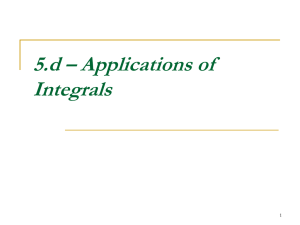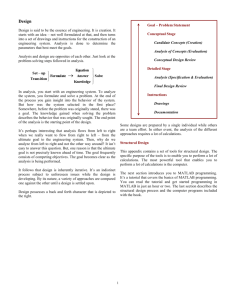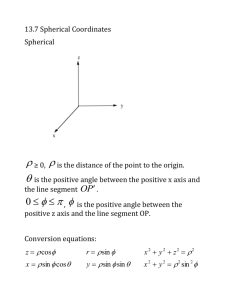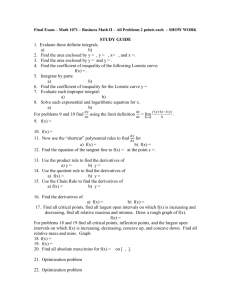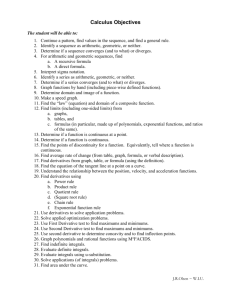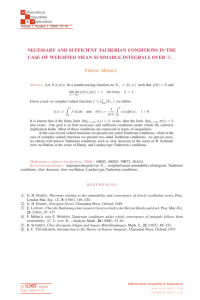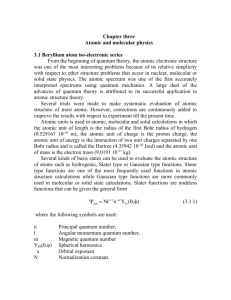Chapters 6 & 7 Study Guide (6.1, 6.4, 7.1
advertisement
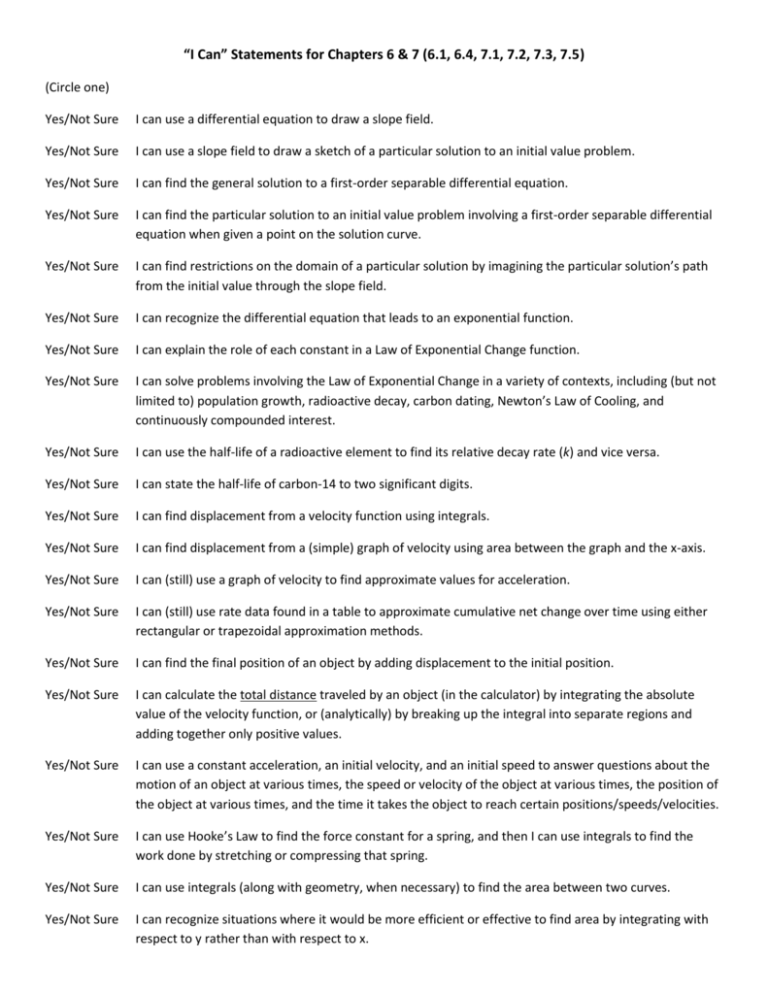
“I Can” Statements for Chapters 6 & 7 (6.1, 6.4, 7.1, 7.2, 7.3, 7.5) (Circle one) Yes/Not Sure I can use a differential equation to draw a slope field. Yes/Not Sure I can use a slope field to draw a sketch of a particular solution to an initial value problem. Yes/Not Sure I can find the general solution to a first-order separable differential equation. Yes/Not Sure I can find the particular solution to an initial value problem involving a first-order separable differential equation when given a point on the solution curve. Yes/Not Sure I can find restrictions on the domain of a particular solution by imagining the particular solution’s path from the initial value through the slope field. Yes/Not Sure I can recognize the differential equation that leads to an exponential function. Yes/Not Sure I can explain the role of each constant in a Law of Exponential Change function. Yes/Not Sure I can solve problems involving the Law of Exponential Change in a variety of contexts, including (but not limited to) population growth, radioactive decay, carbon dating, Newton’s Law of Cooling, and continuously compounded interest. Yes/Not Sure I can use the half-life of a radioactive element to find its relative decay rate (k) and vice versa. Yes/Not Sure I can state the half-life of carbon-14 to two significant digits. Yes/Not Sure I can find displacement from a velocity function using integrals. Yes/Not Sure I can find displacement from a (simple) graph of velocity using area between the graph and the x-axis. Yes/Not Sure I can (still) use a graph of velocity to find approximate values for acceleration. Yes/Not Sure I can (still) use rate data found in a table to approximate cumulative net change over time using either rectangular or trapezoidal approximation methods. Yes/Not Sure I can find the final position of an object by adding displacement to the initial position. Yes/Not Sure I can calculate the total distance traveled by an object (in the calculator) by integrating the absolute value of the velocity function, or (analytically) by breaking up the integral into separate regions and adding together only positive values. Yes/Not Sure I can use a constant acceleration, an initial velocity, and an initial speed to answer questions about the motion of an object at various times, the speed or velocity of the object at various times, the position of the object at various times, and the time it takes the object to reach certain positions/speeds/velocities. Yes/Not Sure I can use Hooke’s Law to find the force constant for a spring, and then I can use integrals to find the work done by stretching or compressing that spring. Yes/Not Sure I can use integrals (along with geometry, when necessary) to find the area between two curves. Yes/Not Sure I can recognize situations where it would be more efficient or effective to find area by integrating with respect to y rather than with respect to x. Yes/Not Sure When integrating with respect to y, I can solve equations for x (in terms of y), set up the integrand correctly, and use the proper bounds along the y-axis. Yes/Not Sure When I need to integrate cos2x or sin2x analytically, I can use the double-angle identity for cosine to rewrite the integrand in a new form. Yes/Not Sure I can sketch a region that is bounded by specified lines and curves (with or without the calculator). Yes/Not Sure I can find volume by finding the integral of a solid’s cross-sectional area. Yes/Not Sure I can find a function for the cross-sectional area of a solid when the cross-sections are familiar geometric shapes (like squares, rectangles, triangles, circles, semi-circles, etc.). Yes/Not Sure I can determine whether the cross-sections of a solid of revolution (that are perpendicular to the axis of revolution) are disks or washers. Yes/Not Sure I can use the disk method and the washer method to find the volume of a solid formed by revolving a 2dimensional region around any horizontal or vertical axis (not just the x-axis or the y-axis). Yes/Not Sure I can use the method of cylindrical shells to find the volume of a solid of revolution (for extra credit). Yes/Not Sure I can use Cavalieri’s Theorem to argue that two solids with identical cross-sectional areas must have the same volume. Yes/Not Sure I can use integrals to find the work done moving/lifting a force/weight that is not constant (like a leaky bucket of water). Yes/Not Sure I can use integrals to calculate the work done pumping a liquid out of a container by considering thin cross-sections of the liquid that move a non-constant distance. Yes/Not Sure I can use integrals to calculate the fluid force pressing up against a side (or a part of a side) of a container by considering the non-constant pressure exerted upon thin areas. Yes/Not Sure I can use the formula density times depth (w*h) to find pressure and force times distance to find work. Yes/Not Sure I can model a variety of word problem situations as integrals by thinking about Riemann sums created by “representative rectangles.”


